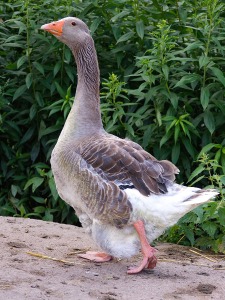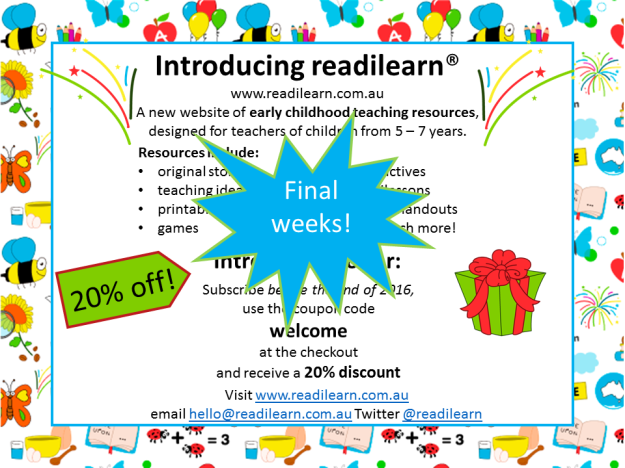
This week at the Carrot Ranch Charli Mills has challenged writers to In 99 words (no more, no less) write using the word gander as a verb.
Gander, the verb, means to look. Since a gander, a male goose, has a long neck which is, without doubt, suitable for sticking out and into things, the meaning to take a look is probably apt. However, I must say that, until reading Charli’s flash pieces, I was unfamiliar with its use as a verb, and still feel a bit uncomfortable in using it so, but I’ll give it a go – later.
First: What I would love is for people to take a gander at readilearn, a website I have been working on for more years that I care to tally right now.
It is a year since I took the leap and engaged a company to develop the site. It was nine months (not the one month promised) before the site was launched, just over three months ago. To use the nine months analogy of pregnancy; it wasn’t an easy gestation or birth, and we’re still experiencing teething problems and growing pains, including “how to grow?” pains.
Audience wanted

Marketing, as in attracting, building, and maintaining an audience, is difficult, as any writer knows. It is not just a matter of writing the stuff and hoping an audience finds it. It takes time, effort, and know-how. I’m a bit short on all three, but I’m going to stick my neck out, and ask if you’d be willing to help me a little with the know-how in finding my target audience.
readilearn is a collection early childhood teaching resources. The target audience is teachers of children between 5 and 7 years of age, be they teaching in a school environment, or homeschooling their children. The resources are also suitable or use with children learning English as a second or other language, and with children with special needs.

There are resources for most areas of the curriculum, with suggestions for integrating learning across curriculum areas in a meaningful context.
The materials are Australian (I’m Australian) but are suitable for use internationally.
There are:
- Digital and interactive resources to access and use online
- Word and PDF documents to download and print
Including:
- Original stories
- estories (digital stories)
- Teaching ideas and suggestions
- Lessons plans
- Readilessons (lessons ready to use)
- Games
- Printouts for parents
Features
- New resources are added almost every week
- Many resources are free to registered users
- An annual subscription of less than 50c per week (or less than the cost of 5 cups of coffee a year!) is easily affordable; and that’s Australian dollars – even less for UK and US subscribers! It’s even discounted until the end of 2016!

So what’s different?
I think that what differentiates readilearn is the integrated resources focusing on purposeful learning in context. The open-ended nature of many of interactive resources allows teachers to adjust the discussion to suit the needs of their students. readilearn is not just bunch of worksheets for repetitive practice of skills in isolation, or endless pretty charts to hang in the room. It is designed to support effective teaching and learning in meaningful contexts.
More than just resources
- Each Friday I publish a blog post filled with teaching ideas and information, including how to get the most from readilearn resources.
- I also email users each Friday to inform them of new resources uploaded during the week – no more wondering if there’s anything new or where to find it.
- The newsletter, published on the last day of each month, includes a summary of blog posts, a list of new resources, and a preview of events in the coming month.
I would very much appreciate it if you could spread the word to any of my target audience in your circles: teachers of children from 5 – 7 years. I’d also love some suggestions for ways of connecting with my audience. Although my audience may differ from yours, what you have learned may also be useful for me.
Maybe you’d like to gift an early childhood teacher their first year’s subscription. It’s easy. Just email hello@readilearn.com.au to find out how.

Now back to Charli’s challenge to include gander as a verb in a 99-word story. It got me thinking about all the bird words in common use, even when not referring to birds. I decided to incorporate as many as I could into a story while still maintaining a certain amount of sense. I have used over twenty. Can you (bird)spot them all? I hope you think it’s grouse! (Well, maybe just a little bit not too bad. 🙂 )

Bird (non)sense
Finch’d had an eagle eye on the play all day.
Robin’d been hawking chicken pies. Now sold out, he wandered over to gander with Finch.
Robin craned his neck, just as “He’s out for a duck!” was announced.
“He’s out for a duck,” he parroted. “That’s something to crow about.” One team was swanning around, exuberant as monarchs. The other was as despondent as miners on strike.
Martin was larking around. “Yeah,” he sniped. “The silly goose was distracted by the kite and missed altogether.”
“More like a turkey, I’d say,” Robin reterned swiftly.
“You’re a hoot!” chirped Finch.

Thank you for reading. I appreciate your feedback. Please share your thoughts.


